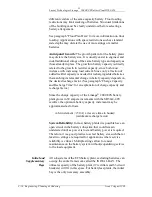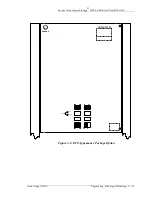
Lucent Technologies Lineage
®
2000 ECS Battery Plant H569-416
3 - 20 Engineering, Planning & Ordering
Issue 2 August 1996
For nontypical ECS configurations where the supplementary
bays are not located adjacent to the initial bay, battery cables
must be engineered.
Five sizes of plug-in circuit breakers are available for dc
distribution overcurrent protection. The ratings of these circuit
breakers are 10, 20, 30, 45 and 60 amperes. Two screw panel
mount breakers with current ratings of 100 and 225 amperes are
also available. The breaker rating for a given circuit is selected
by the criteria covered in paragraph “Overcurrent Protection.”
The lengths of all load and battery conductors must be known
before proceeding with this paragraph. Use the following steps
to record the wire and breaker sizes for each load feeder in Table
3-F. Use additional sheets as needed.
Step A: Copy List 2 drains for each load feeder from Table 3-B
to Table 3-F.
Step B: Calculate the minimum wire size that meets the
ampacity requirement based on the List 2 drain for each load
feeder.
Step C: List the wire sizes based on ampacity in Table 3-F.
Step D: Calculate the minimum wire size for each load feeder in
Table 3-B to meet the voltage drop requirements outlined in
paragraph “Calculating Voltage Drop.”
Step E: List the sizes based on voltage drop in Table 3-F.
Step F: Indicate the larger size for each load feeder in the
column marked “Selected Wire Gauge.”
Step G: Fill in the circuit breaker rating (10, 20, 30, 45 or 60
amperes) in Table 3-F for each feeder.
Step H: Record in Table 3-G the wire sizes for each battery
feeder.
Step I: Calculate the minimum wire size that meets the
ampacity requirement based on the total plant List 1 drain
divided by the number of parallel battery strings.
Step J: Enter that wire size on the first line in Table 3-G.
















































